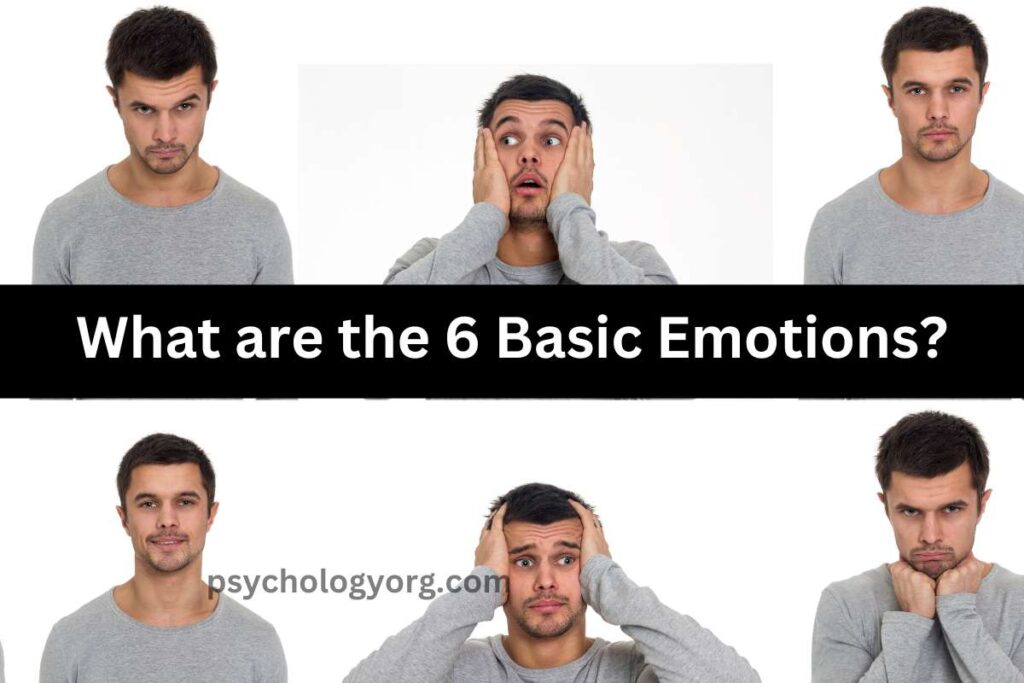What Are The 6 Basic Emotions And Their Characteristics?
The 6 basic emotions are happiness, sadness, anger, fear, surprise, and disgust. These emotions are considered universal and are experienced by people across different cultures.
According to Paul Ekman’s theory, the six basic human emotions are joy, sadness, fear, anger, disgust, and surprise. They are considered universal since they are believed to be innate. Emotions play a very important role in our lives, as they help us to modulate our behavior and act quickly in situations where it is necessary.
Table of Contents
t is important to note that emotions are complex and can vary in intensity and nuances depending on the cultural and personal context of each individual. In this Psychologyorg article, we explain what are the 6 basic emotions and their characteristics.

Happiness
Joy is a positive emotion that is experienced in situations of well-being, happiness, satisfaction, or pleasure. It is characterized by a facial expression of a smile, bright eyes, and open and relaxed body gestures. Because of the way we phrase it, it doesn’t seem to have any sort of survival function. It does not seem to be more than a reflection of our internal state, however, joy is one of the body systems that moves us to action.
It is also a reward for behavior that brings us benefits. When we take some kind of action that accomplishes a goal, happiness arises. Thanks to that sensation of pleasure, we will replicate that behavior to experience happiness again. These may be the most natural motivators we have. At the physiological level, an increase in heart rate and a better respiratory rate are observed. On top of that, we find that the brain releases more endorphins and dopamine.

Sadness
Sadness is a negative emotion that arises in response to loss, grief, or disappointment. It is characterized by a drooping facial expression, tears, hunched body gestures, and a sense of regret. This emotion involves a decrease in mood, as well as a significant reduction in cognitive and behavioral activity.
The main characteristics of sadness are the following:
- The feeling of regret: sadness is characterized by a feeling of emotional charge, a feeling of weight or emptiness in the heart. It may be accompanied by a feeling of loneliness or hopelessness.
- Downcast facial expression: When we are sad, our facial expression is usually duller. The facial muscles may relax, the lips may curl downward, and the eyebrows may pucker slightly.
- Crying: is a common response to sadness. Crying can be a way to release pent-up sadness and provide emotional relief.
- Social withdrawal: sadness can lead us to isolate ourselves and seek moments of solitude. We may be less interested in social activities and prefer to be alone to reflect on or process our emotions.

Fear
If we talk about basic human emotions, fear is a negative or adverse emotional state. It implies a high activation that leads to avoiding and escaping from dangerous situations. The experience of fear is that of high tension, along with concern for one’s health and safety.
The correlated physiological characteristics show us a quick elevation of activation and practice for flight. Heart activity skyrockets and breathing quickens. Breathing becomes shallow and irregular. Fear is an evolutionary legacy that has obvious survival value. This emotion is useful to prepare the body and provoke survival behaviors in potentially dangerous situations. In addition, it helps to learn new protective responses.

Anger
Anger is one of the basic universal emotions that arise when an individual is in situations that produce frustration or aversion. The experience of anger is unpleasant. It is accompanied by a feeling of tension that drives us to act. It is a multifaceted emotion and, in many cases, ambiguous. Specifically, the characteristics of anger are:
- Feeling angry and hostile: Anger is characterized by an intense feeling of anger and hostility toward the situation or person we hold responsible for our frustration or perceived injustice.
- Angry Facial Expression – When we are angry, our facial expression may show a piercing look, a frown, pursed lips, and tension in the facial muscles.
- Increased energy – Anger is often accompanied by an increase in physical and mental energy. We feel more alert, activated, and prepared to face the situation that provoked our anger.
- Aggressive or confrontational responses – Anger can trigger aggressive or confrontational responses, both verbal and physical. We may have the urge to express our anger through arguments, confrontations, or even acts of violence.
- Irritability and muscle tension: Anger can lead to constant irritability and muscle tension. We may experience a feeling of stiffness, clench our fists, or have sudden movements.
- Increased Heart Rate and Blood Pressure – Anger can activate the sympathetic nervous system, resulting in increased heart rate, blood pressure, and a general feeling of physiological arousal.

Disgust
According to Paul Ekman’s theory, disgust is a basic emotion that we experience in response to unpleasant, disgusting, or potentially harmful stimuli. Some characteristics of disgust include:
- The feeling of revulsion: Disgust is characterized by an intense feeling of revulsion and aversion towards a specific stimulus, such as nauseating odors, spoiled food or polluting substances.
- Disgusted Facial Expression – When we feel disgusted, our facial expressions may include nose wrinkles, pursed lips, a frown, and a clearly visible expression of disgust.
- Avoidance Response – Disgust is often accompanied by an avoidance response. We instinctively try to move away from or avoid the unpleasant stimulus that causes us to feel disgusted.
- Feeling Nauseous or Upset Stomach – This emotion can trigger feelings of nausea or upset stomach. It is common to experience a feeling of turmoil in the stomach or feel like vomiting when faced with stimuli that are repugnant to us.
- Decreased Appetite: Disgust can decrease our appetite and make it difficult for us to eat or enjoy food when exposed to stimuli we find repulsive.
- Increased sensitivity to unpleasant stimuli: Disgust can cause us to be more sensitive to unpleasant stimuli in general, even those that would not normally disgust us. Our tolerance for unpleasant odors, tastes, or textures may be reduced.
It is important to note that disgust fulfills an adaptive function by helping us avoid substances that are toxic or dangerous to our health. However, the intensity and sensitivity to disgust can vary from person to person, and what may be repulsive to one person may not be to another.

Surprise
According to psychology, surprise is a primary emotion caused by something unexpected, new, or strange. In other words, it is when a stimulus appears that the subject had not thought of beforehand. The subjective experience that accompanies surprise is a transitory sensation of uncertainty and its duration varies depending on the stimulus and the person. The characteristics of the surprise are the following:
- Shocked Facial Expression – When we are surprised, our facial expression is usually wide-eyed, raised eyebrows, and open-mouthed. Our gaze may be fixed on the surprising stimulus.
- Momentary suspension: Surprise can cause a brief pause or freeze in our actions or thoughts. We momentarily go without reaction as we process and assimilate the new information.
- Fast heart rate – This emotion can cause a temporary increase in heart rate and breathing. The organism is activated in response to the surprising stimulus.
- Feeling Alert and Focused Attention – Surprise awakens our attention and makes us more alert. We focus on the new stimulus and may experience a feeling of greater mental clarity.
- Possibility of Mixed Emotions – Depending on the nature of the surprising stimulus, the surprise may be accompanied by additional emotions, such as joy, fear, confusion, or disbelief. Surprise can be the first step towards experiencing other emotions.
- Desire to explore or investigate – This basic emotion can arouse our curiosity and motivate us to explore or investigate the stimulus further. We want to understand and learn more about what has surprised us.

If you want to read more articles similar to What are the 6 basic emotions and their characteristics, we recommend that you enter our Psychology category.
Read Also: XNXJ Personality Type Test: Unique Traits and Strengths
FAQs – The 6 Basic Emotions
Q1: What are the six basic emotions?
A1: The six basic emotions are happiness, sadness, anger, fear, surprise, and disgust. These emotions are considered universal and are experienced by people across different cultures.
Q2: How are the six basic emotions defined?
A2: The six basic emotions are defined as follows:
- Happiness: A positive emotion characterized by feelings of joy, contentment, and satisfaction.
- Sadness: A negative emotion associated with feelings of sorrow, grief, and unhappiness.
- Anger: A strong emotion accompanied by feelings of hostility, frustration, and outrage.
- Fear: An emotional response triggered by a perceived threat or danger, leading to feelings of anxiety and apprehension.
- Surprise: An emotion experienced when something unexpected or surprising occurs.
- Disgust: A negative emotion elicited by things that are perceived as unpleasant, offensive, or repulsive.
Q3: Are these six basic emotions universal?
A3: Yes, these six basic emotions are considered universal because they are found across cultures and are recognized and expressed in similar ways by people around the world. However, the intensity and cultural expressions of these emotions may vary.
Q4: Can a person experience multiple emotions at the same time?
A4: Yes, it is common for people to experience multiple emotions simultaneously. Emotions are complex and can arise from various factors and situations, so it’s possible to feel a combination of happiness, sadness, anger, fear, surprise, and disgust all at once or in quick succession.
Q5: Are there any other emotions apart from the six basic ones?
A5: While the six basic emotions provide a foundation for understanding human emotional experiences, there are other complex emotions that may arise from combinations or variations of the basic emotions. Examples include love, envy, guilt, shame, pride, and many more. These secondary emotions often result from social and cultural factors.
Q6: Can emotions be controlled or managed?
A6: While emotions are natural and spontaneous reactions to internal and external stimuli, it is possible to regulate and manage them to some extent. Techniques such as mindfulness, deep breathing, cognitive reframing, and seeking support from others can help individuals develop emotional self-regulation skills and cope with intense emotions in healthier ways. However, it’s important to note that emotions are a normal part of being human, and experiencing them is natural and necessary for our overall well-being.
Please note that these FAQs are meant to provide general information about the six basic emotions and are not intended to replace professional advice or guidance. If you have specific concerns about your emotional well-being, it is recommended to consult with a mental health professional.







